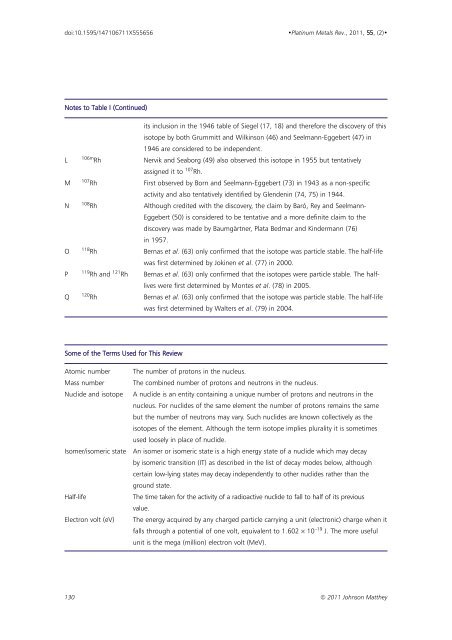Download - Platinum Metals Review
Download - Platinum Metals Review
Download - Platinum Metals Review
Create successful ePaper yourself
Turn your PDF publications into a flip-book with our unique Google optimized e-Paper software.
doi:10.1595/147106711X555656<br />
•<strong>Platinum</strong> <strong>Metals</strong> Rev., 2011, 55, (2)•<br />
Notes to Table I (Continued)<br />
its inclusion in the 1946 table of Siegel (17, 18) and therefore the discovery of this<br />
isotope by both Grummitt and Wilkinson (46) and Seelmann-Eggebert (47) in<br />
1946 are considered to be independent.<br />
L<br />
106m Rh<br />
Nervik and Seaborg (49) also observed this isotope in 1955 but tentatively<br />
assigned it to 107 Rh.<br />
M 107 Rh First observed by Born and Seelmann-Eggebert (73) in 1943 as a non-specific<br />
activity and also tentatively identified by Glendenin (74, 75) in 1944.<br />
N<br />
108 Rh Although credited with the discovery, the claim by Baró, Rey and Seelmann-<br />
Eggebert (50) is considered to be tentative and a more definite claim to the<br />
discovery was made by Baumgärtner, Plata Bedmar and Kindermann (76)<br />
in 1957.<br />
O<br />
118 Rh Bernas et al. (63) only confirmed that the isotope was particle stable. The half-life<br />
was first determined by Jokinen et al. (77) in 2000.<br />
P<br />
119 Rh and 121 Rh Bernas et al. (63) only confirmed that the isotopes were particle stable. The halflives<br />
were first determined by Montes et al. (78) in 2005.<br />
Q<br />
120 Rh Bernas et al. (63) only confirmed that the isotope was particle stable. The half-life<br />
was first determined by Walters et al. (79) in 2004.<br />
Some of the Terms Used for This <strong>Review</strong><br />
Atomic number<br />
Mass number<br />
Nuclide and isotope<br />
Isomer/isomeric state<br />
Half-life<br />
Electron volt (eV)<br />
The number of protons in the nucleus.<br />
The combined number of protons and neutrons in the nucleus.<br />
A nuclide is an entity containing a unique number of protons and neutrons in the<br />
nucleus. For nuclides of the same element the number of protons remains the same<br />
but the number of neutrons may vary. Such nuclides are known collectively as the<br />
isotopes of the element. Although the term isotope implies plurality it is sometimes<br />
used loosely in place of nuclide.<br />
An isomer or isomeric state is a high energy state of a nuclide which may decay<br />
by isomeric transition (IT) as described in the list of decay modes below, although<br />
certain low-lying states may decay independently to other nuclides rather than the<br />
ground state.<br />
The time taken for the activity of a radioactive nuclide to fall to half of its previous<br />
value.<br />
The energy acquired by any charged particle carrying a unit (electronic) charge when it<br />
falls through a potential of one volt, equivalent to 1.602 × 10 –19 J. The more useful<br />
unit is the mega (million) electron volt (MeV).<br />
130 © 2011 Johnson Matthey
















